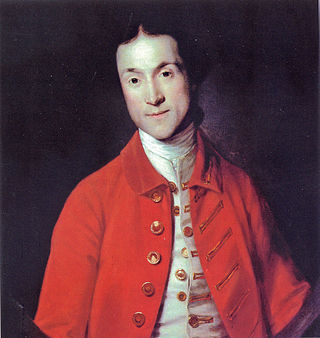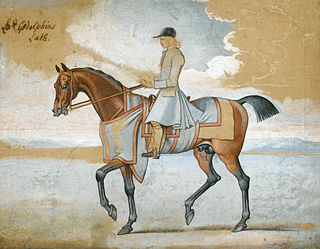Related Research Articles
Young Eclipse was a Thoroughbred racehorse that won the 1781 Epsom Derby. He raced until he was six years old, winning seven races and retiring to stud in 1785. He was not a successful sire.
Assassin was a Thoroughbred racehorse that won the 1782 Epsom Derby. His breeder, Lord Egremont, won the Derby for the first time with Assassin. Assassin raced until he was a five-year-old and was retired to Egremont's stud in Petworth. He was not a successful sire.
Aimwell was a British Thoroughbred racehorse. In a career that lasted from autumn 1784 to spring 1786, he ran eight times and won five races. In 1785, he won the sixth running of the Epsom Derby as well as three races at Newmarket. He was beaten in his only race in 1786, and did not appear in any subsequent records.
Serjeant was a British Thoroughbred racehorse. In a career that lasted from spring 1784 to autumn 1787 he ran sixteen times and won eight races. In 1784 he won the fifth Epsom Derby, the first running of the race under its current name and distance. He stayed in training for a further three seasons, winning several important races at Newmarket, but disappeared from official records after his retirement from racing and does not appear to have been found a place at stud.

Snap was a Thoroughbred racehorse who won all four of his races. After retiring from racing he became a successful stallion. He was Champion sire four times and his progeny included the undefeated Goldfinder.
Bartlett's Childers was an important Thoroughbred sire in the 18th century.

Goldfinder (1764–1789) was an undefeated Thoroughbred racehorse. His wins included two Newmarket Challenge Cup and Whips. After retiring from racing he became a successful sire.

Bay Bolton or Brown Lusty (1705–1736) was a British Thoroughbred racehorse who won Queen Anne's Gold Cup as a five-year-old in 1710. After retiring from racing he became a successful sire for the Charles Paulet, 2nd Duke of Bolton, and his son Charles Powlett, 3rd Duke of Bolton, was Champion sire seven times.
Bucephalus was a British Thoroughbred racehorse. He won the Subscription Purse at York in 1768, but is best known for racing against the undefeated Eclipse in a match race in 1770.

The Great Subscription Purses were a series of flat horse races in Great Britain run at York Racecourse, usually over a distance of 4 miles, that took place each year in August from 1751 to 1833. During the second half of the 18th century they were amongst the most important races in the county, but during the 19th century their importance declined as racing became more focused on shorter distances.
Blank (1740–1770) was a British Thoroughbred racehorse and sire. He only won one race, but became a very successful sire and was British Champion sire in 1762, 1764 and 1770.
The 1400 Guineas Stakes was a flat horse race in Great Britain open to thoroughbreds aged four years. It was run at Newmarket and was one of the most important races of the second half of the 18th century.
Crab also known as Old Crab and Mr. Panton's Crab was a British Thoroughbred racehorse. After retiring from racing he became a successful stallion and was British Champion sire in 1748, 1749 and 1750. He was owned by the 1st Earl of Portmore until purchased by Mr. Cotton and then Thomas Panton.
Spilletta was a British Thoroughbred racehorse. She only raced once and is best known for being the dam of the undefeated Eclipse.

Sweetbriar was a British Thoroughbred racehorse. He won all eight of the races he contested, including a match race against Craven Stakes winner Firetail. He later became a successful stallion, with his progeny including Epsom Derby winner Assassin.

Alipes (1757) was an undefeated British Thoroughbred racehorse who won all eight of her races, including the 1761 Great Subscription Purse. She was owned by Sir B. Graham and later Richard Grosvenor.
Snip was a British Thoroughbred racehorse. He only won one race, but later became a successful sire. His son Snap was undefeated in his four races and became a multiple-time Champion sire. Snip was bred and owned by William Cavendish, 3rd Duke of Devonshire.
Hollandoise, or alternatively Hollandaise, (1775–1782) was a grey British Thoroughbred mare that won the 1778 St. Leger Stakes, the first horse to win the event under its formal title. Raced sporadically from 1778 to 1782, Hollandoise won eight races in 14 starts. She died suddenly shortly after her last race in 1782 before producing any offspring.

Lath was a British Thoroughbred racehorse. He won at least four races, including a 1000-guinea sweepstakes at Newmarket and a match race against Squirt. After retiring from racing he became a stallion and produced a number of high-class runners and also sired the grand-dam of St. Leger winner Hollandoise.
Squirrel was a British Thoroughbred racehorse. He won seven of his nine races, including the 1400 Guineas Stakes and match races against Dapper and Jason. He was also a successful stallion, siring Craven Stakes winner Firetail. However he was more well known for producing broodmares, siring the dams of seven Classic winners including Derby winner Noble, along with the dam of champion sire Trumpator. Squirrel was owned by Jenison Shafto.
References
- Pick, William; Johnson, R. (1803). The Turf Register (Vol. I). A. Bartholoman, High-Ousegate.
- Pick, William; Johnson, R. (1805). The Turf Register (Vol. II). A. Bartholoman, High-Ousegate.
- Johnson, R. (1822). The Turf Register (Vol. III). A. Bartholoman, High-Ousegate.